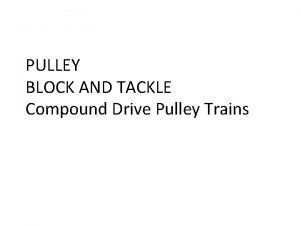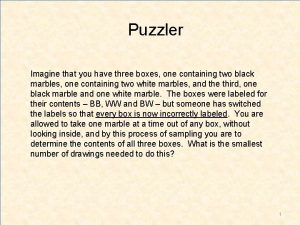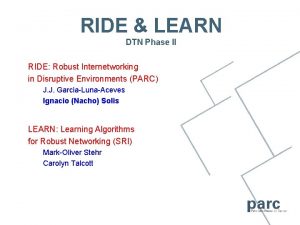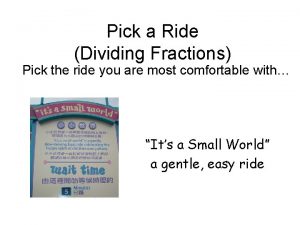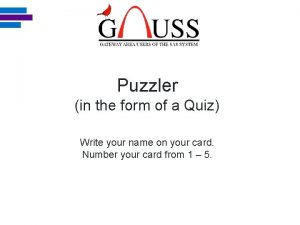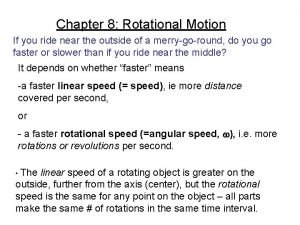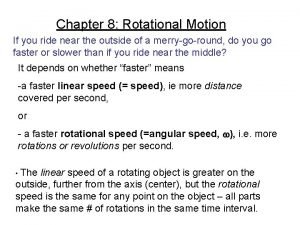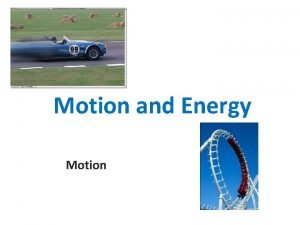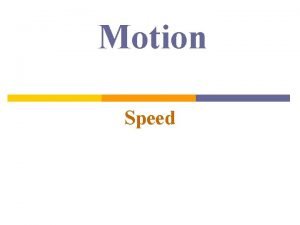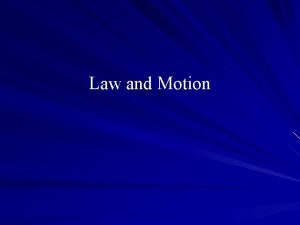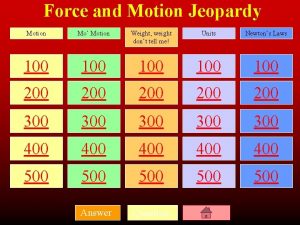DAY 1 Motion A Puzzler You ride your



























- Slides: 27

DAY 1



Motion • A Puzzler – You ride your bike from Ossining to NYC, 30 miles away at 15 mph. How fast must you return to Ossining to average 30 mph?

Motion • A Puzzler – You ride your bike from Ossining to NYC, 30 miles away at 15 mph. How fast must you return to Ossining to average 30 mph? • Ans – It is impossible. You would have to return in 0 hours. Why? • Q- Determine the general formula for average velocity in terms of v 1 and v 2

Motion • V ave = 2 v 1 v 2 /(v 1 + v 2) • This is only true if the distance for trip 1 and 2 are the same.

Motion along a straight line • 1) We will only discuss straight line motion • 2) No causes of motion yet • 3) discuss all objects like particles • 4) Choose the center of mass as a point – like an elephant?

Displacement • Choice is + or – • Displacement, Dx = x 2 – x 1 • Displacement vs Distance • Ex) x 1 = 9 m x 2 = -6 m

Average Velocity • vave = total distance / total time • This really doesn’t tell you about the details of the trip. • More importantly you need to determine the instantaneous speed

Velocity • vave = Dx/Dt = x 2 – x 1/t 2 – t 1 • Its the slope of x vs t • But in order to get the instantaneous velocity, you must make the interval smaller and smaller, Dt approaches zero.

Calculus • v = lim as t approaches 0 of Dx/Dt = dx/dt in calculus words • dee x, dee t In calculus terms, the instant velocity is the rate at which an objects position is changing with respect to time at a given instant.

dx/dt = v • If we know the location of an object as a function of time, we can determine its speed. x = 5 t 2 dx/dt = v = d(5 t 2)/dt = 10 t • ex) x = 3 t 2 + 5 • • ex) x = t 2 - 8 t + 16

dx/dt = v • If we know the location of an object as a function of time, we can determine its speed. x = 5 t 2 dx/dt = v = d(5 t 2)/dt = 10 t • ex) x = 3 t 2 + 5 dx/dt = 6 t • • ex) x = t 2 - 8 t + 16 dx/dt = 2 t + 8


Acceleration • Acceleration, a, is the rate of change of velocity

Acceleration • Acceleration, a is the rate of change of velocity • a = Dv/Dt • = v 2 – v 1/(t 2 – t 1) • a = dv/dt = d 2 x/d 2 t the second derivative units are m/s/s

Below is an x vs t graph, draw the v vs t and a vs t graphs

• When v is constant, acceleration is zero graph of v vs t slope Dv/Dt • *** your body reacts to acceleration - not velocity. •

Given an x vs t graph, one can calculate the slope at every point in order to determine the v vs t graph and then the a vs t graph. Sketch these graphs on your dry erase boards.


Determine the v vs t and a vs t from this graph


Introduction to Integration • The area under v vs t is the displacement. This process is called the antiderivative or integral between two points. V in m/s t in s

Introduction to Integration • d = (vo + vf)/2 * t V in m/s t in s

Introduction to Integration • d = (vo + vf)/2 * t • or d = ½ at 2 + vot

Constant Acceleration • It is a special case when the acceleration is constant. • draw d vs t, v vs t, a vs t and compare use a = -9. 8 m/s/s

Equations for Constant a • v = vo + at • vave = (v + vo)/2 • x - xo = vave t • Dx = ½ at 2 + vot
 Enthymeme
Enthymeme Pulley system
Pulley system Day 1 day 2 day 3 day 4
Day 1 day 2 day 3 day 4 Day 1 day 2 day 817
Day 1 day 2 day 817 As your room gets messier day by day, entropy is
As your room gets messier day by day, entropy is You put your left foot in
You put your left foot in Fasten your seatbelts we're in for a bumpy ride
Fasten your seatbelts we're in for a bumpy ride You say you love the rain
You say you love the rain If you wanna ride
If you wanna ride Perceptual interpretation in consumer behavior
Perceptual interpretation in consumer behavior Unit 2 what do you do
Unit 2 what do you do Give us your hungry your tired your poor
Give us your hungry your tired your poor Accept your loneliness you are your only friend
Accept your loneliness you are your only friend If you have a problem with your brother leave your offering
If you have a problem with your brother leave your offering Maintaining a healthy body composition and body image quiz
Maintaining a healthy body composition and body image quiz Please clean your own room
Please clean your own room How to know if pms or pregnant
How to know if pms or pregnant Active rom
Active rom Simple harmonic motion equation of motion
Simple harmonic motion equation of motion An object in motion stays in motion
An object in motion stays in motion Chapter 2 section 1 describing motion answer key
Chapter 2 section 1 describing motion answer key Describing and measuring motion
Describing and measuring motion Section 1 describing motion answer key
Section 1 describing motion answer key Concept 1 notes describing motion
Concept 1 notes describing motion Motion section 1 describing motion
Motion section 1 describing motion William beanes elementary
William beanes elementary Haiku and
Haiku and Day to day maintenance
Day to day maintenance

